 Monday is the first day of the Texas 200, a 200 mile raid/rally/cruise along the bay and estuary system of south Texas. As one of the more than 40 participants of the inaugural event, Kellan Hatch will be carrying a SPOT gps device which allows him to send regular postion reports to Duckworks. We will post those positions along with regular updates on a special page [click here]. Below is the story of the unusual boat he is bringing for the event. - Chuck Monday is the first day of the Texas 200, a 200 mile raid/rally/cruise along the bay and estuary system of south Texas. As one of the more than 40 participants of the inaugural event, Kellan Hatch will be carrying a SPOT gps device which allows him to send regular postion reports to Duckworks. We will post those positions along with regular updates on a special page [click here]. Below is the story of the unusual boat he is bringing for the event. - Chuck |
Trusting Your Life to a Piece of Air
With Some Fabric Wrapped Around It
 |
“Fan-fugu-tastic!”
-Homer Simpson
(click images to enlarge) |
The Texas 200 was less than two months away when things started to fall apart. The plan was for me to fly into San Antonio while Chris trailered the XCR from Utah to the southern tip of Texas. He would pick me up at the airport en route to the launch point at Port Mansfield. For want of a crystal ball there was no way we could have known that our plan was going to implode.
I had made my plane reservation months in advance and I was determined to go somehow, so I started scratching my head for another option. What I needed now was some kind of crazy, half-baked Plan B scheme to further complicate things. The only one I could come up with was to bring a collapsible boat of some sort along with me on the plane. I already owned an inflatable kayak, a sail or two, and a shop full of odds and ends. I decided that I would put together a portable inflatable sailboat capable of surviving the two hundred mile raid but compact enough to be checked onto an airliner as baggage.
I had naively imagined myself checking in a couple of oversize, overweight bags and paying a few extra dollars for the overages. Imagine my shock when I looked up Delta’s baggage allowances and discovered that the overages would cost me $1000 dollars extra for a round trip!
So my Plan B now had two daunting design limitations. The first was that time stands still for no man. The second was that I was determined to fit my boat into two checkable bags. I’d still have to pay the minimum extra bag fee, since most airlines have recently reduced their allotment to ONE bag. Each bag could weigh no more than 50 pounds and its total dimensions (length+width+height) could add up to no more than 61 inches.
I would give myself a month to build the boat, which would leave about 3 weeks to test, refine and pack. Much of the design and construction would have to happen during hours when I should be sleeping. Hell or high water.
Early in the building process I decided to name the boat Fugu, after the Puffer Fish (aka Blow Fish), although I’m not sure the name fully evokes the sheer quantity of hot air involved in this undertaking. When prepared correctly, the Fugu is delightful, so I’m told. But if done incorrectly it can be deadly, which also seemed appropriate to the task at hand.
| Early in the building process I decided to name the boat Fugu, after the Puffer Fish (aka Blow Fish), although I’m not sure the name fully evokes the sheer quantity of hot air involved in this undertaking. |
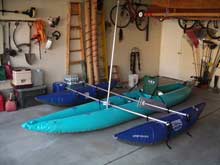 |
I bought the smallest fishing pontoon boat I could find and reinvented the pontoons as amas. They were larger than I would have preferred – I was concerned about too much wetted surface - but they were the most readily available option. I’ve seen smaller inflatable amas for sale on the internet, but in the demo videos they usually seem to be more or less submerged much of the time, which doesn’t strike me as the best low-drag option, either. Once I had the pontoons inflated and sitting alongside the kayak they didn’t look bad, but they were big, so now I was more concerned about windage. As an option, I designed the akas (cross-beams) so that either ama could be removed, converting the boat into an impromptu proa. Fortunately, most of the T200 will be more or less downhill, so windage shouldn’t be a disadvantage for most of the course.
The first big job was to make solid connection points for the outriggers and all of the sail rig components. I used heavy-duty D-ring tie downs designed for river rafts. The akas would slip through four large rings and everything else would strap or clip to smaller rings, all glued to the kayak skin with an industrial strength 2-part cement. I ended up adding 12 of these rings.
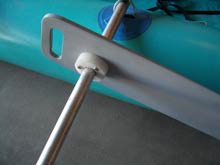 |
I designed the leeboard to sleeve onto the aft aka, with HDPE flanges bolted to either side for resistance to lateral twist. |
After a couple of weeks of furious drilling, cutting, cementing, riveting and general mayhem I had Fugu more or less assembled in my garage. My wacky scheme was threatening fruition. I picked the boat up and stepped onto the bathroom scale. After subtracting my weight (not to be revealed at this time) I was left with an overall weight of seventy pounds. Final tweaks and additions might add another five to ten; well within my limit, and some room for a few tools, spare doo-dads and a paddle, providing I could distribute the weight evenly between the two bags. Add the weight of the bags themselves and I’d probably be right on the hairy edge. I cut the spars and akas to break down into segments of no more than 40 inches to keep everything within my size restrictions. To avoid a third bag, I would ship my camping gear down a week or two ahead of me. Here I need to give a shout out to Chuck Leinweber who will not only be receiving my gear and hauling some of it for me, but also giving me a ride from/to the San Antonio airport. Chuck will also be the guy fishing me out of the water and letting me hitch a ride in the HIGHLY UNLIKELY event that Fugu falls apart after a day or two.
I decided that the 31 sq. ft. balanced lugsail that Lily sewed for Elliot’s Mighty Mouse would be a pretty good choice for Fugu. I built a mast partner from HDPE plastic in two parts that clamp around the forward aka. I designed the leeboard to sleeve onto the aft aka, with HDPE flanges bolted to either side for resistance to lateral twist. The mast step was carved from a solid block PVC, cemented and screwed to a PVC plate that was in turn cemented directly to the floor of the kayak (thanks to Chris Ostlind for that suggestion). Four short stays of low-stretch cord help support the mast and allow me to adjust its rake.
| The mast step was carved from a solid block PVC, cemented and screwed to a PVC plate that was in turn cemented directly to the floor of the kayak. |
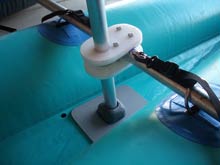 |
The biggest concern in designing Fugu’s sail rig is that there’s no solid undercarriage to this boat – no hull, no gunwales, no solid floor – everything is flexible. Sailing her will be a very organic experience to be sure. The stays will help stiffen things and distribute the force of the wind throughout the boat. A backstay will help a lot, too, especially considering the generally downwind nature of the T200.
Putting a rudder on a narrow inflatable boat is tricky. I could probably steer with a paddle or oar, but I would much rather have a real rudder. I decided that the best way to do this would be to build a small aft deck that cinched up tight to the kayak’s inflatable tubes with webbing straps, with an aft overhang where I could bolt the rudder. This would be about as stiff as I could expect on this type of boat. Hopefully, stiff enough. Steering would be done with a push/pull tiller. I scavenged the rudder from my Mill Creek but machined a new cheek and mounting plate from 1” HDPE plastic. Heavy, but very tough. I made the aft deck from ¼” marine ply laminated on both sides with 6oz cloth to help stiffen it against twisting.
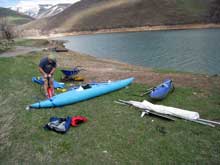 |
Yesterday’s snow had melted, so we ignored the locked gate and carried the boats down the mountainside. The breeze was coming and going randomly as we pumped up the tubes and snapped everything together. |
It looked like I’d be ready for a test sail the first Friday in May, a full month before the T200. Late season snow on Thursday left me I wondering what I’d be up against the next day. Fugu promised to be a wet ride and the water would be cold (and hopefully not still frozen). Undaunted, I loaded everything into the Tundra for a quick getaway from work Friday afternoon. I included another small inflatable kayak for my friend Michael who offered to come along and take pictures and/or perform resuscitation. I chose Little Dell Reservoir, just up the canyon, because it’s close and it’s small enough that a failure wouldn’t leave me blowing out into the middle of something big and scary.
We ditched work early Friday and headed up the canyon only to discover that the reservoir was still closed for the season. There was no ice on it though, and yesterday’s snow had melted, so we ignored the locked gate and carried the boats down the mountainside. The breeze was coming and going randomly as we pumped up the tubes and snapped everything together. I left the fore and back stays detached because I wanted to keep a close eye on how well the baby stays did their job. My other concern was the stiffness of the rudder.
| We plopped Fugu in the water. By the time I was ready to hop aboard the hull was already getting a little limp. The icy water had contracted the air inside, so I pumped each tube a few more strokes and climbed aboard. |
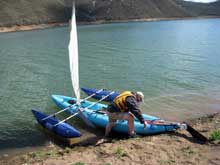 |
We plopped Fugu in the water. By the time I was ready to hop aboard the hull was already getting a little limp. The icy water had contracted the air inside, so I pumped each tube a few more strokes and climbed aboard. After a minute or two of bobbing around, a nice breeze blew in and off I went on a close reach. My first impression was that she went to windward pretty well. A couple of gusts showed me that the baby stays were doing a good job of keeping the mast where I wanted it. I tacked and gibed through a large circle as Michael walked up the hill to snap a few pictures, then he hopped onto the little paddle boat and followed me out. There was a lull in the wind but eventually it gusted up again and off I went. I heard Michael yell “see you later.”
 |
I let go of the tiller and the boat tracked straight for several seconds and then slowly started to round up into the wind. Just right. |
“How does the rudder look?” I called back.
“Great.” I turned around to check it out myself. My concern had been that the rudder would want to crawl sideways and twist the stern of the boat, but it seemed to be holding rock-steady. I centered the leeboard and set the tension on the bungee. Everything seemed well balanced. I let go of the tiller and the boat tracked straight for several seconds and then slowly started to round up into the wind. Just right. After a few minutes the wind slacked off again, so I took the opportunity to make sure I could paddle without interference from any of the stuff I had added. I was pleased with how well I scooted along with the single-blade paddle. I was able to tuck the tiller under the forward aka with enough friction to trim the rudder for straight tracking while I paddled on either side.
By now the sun was getting low and it looked like the wind had abandoned us so we went ashore, deflated and packed up for the long hump back up the mountainside. It had been a good day. I’m hoping to get out one or two more times in bigger wind and waves for a better stress test before the big event. And then…
Texas, here I come.
Kellan Hatch
*****
| PS: - I did get to sail Fugu again at Jim Thayer's annual Starvation meet in May. |
 |
|

